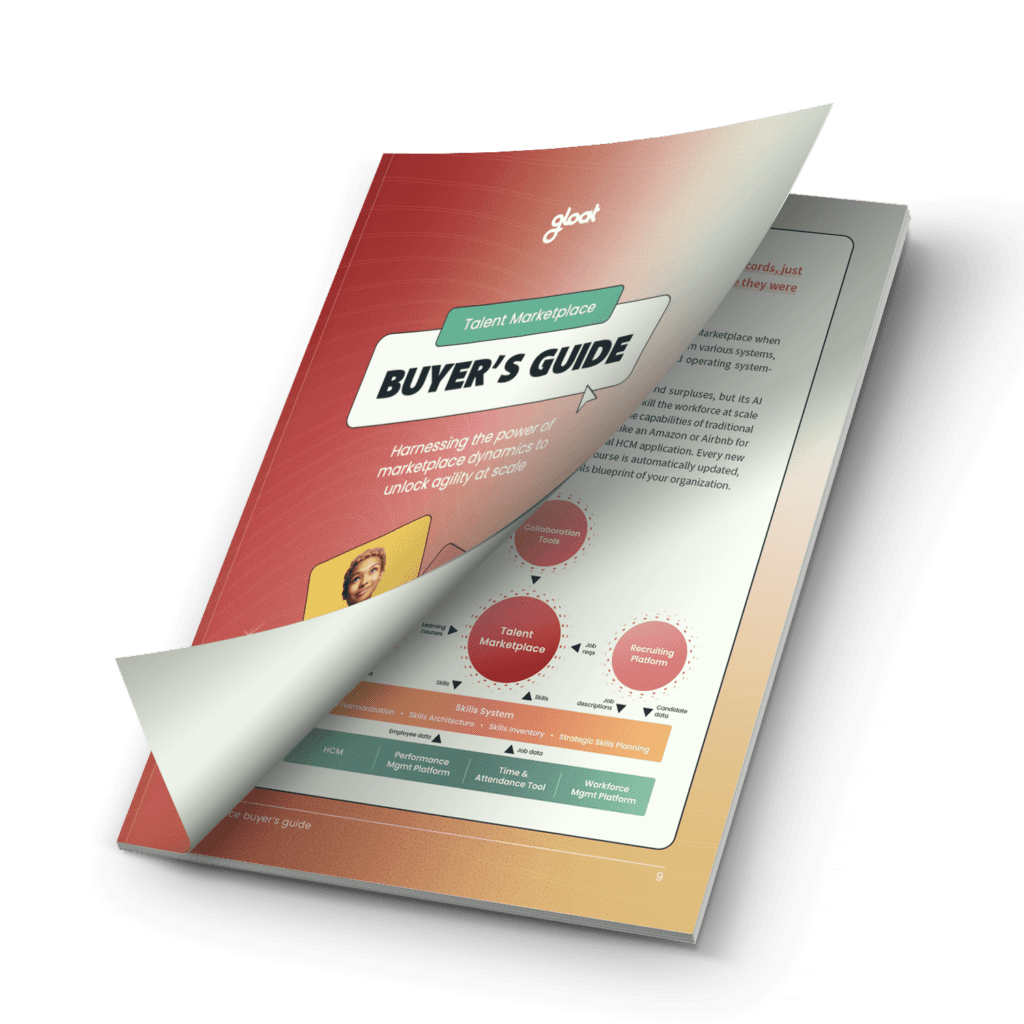5 things to think about before you start a talent marketplace
How to make the most of your platform during every stage of the launch process Talent marketplaces have been gaining recognition for a while. A few years ago, Gartner named implementing a system as one of the top initiatives CIOs can lead to drive value. Schneider Electric credited its marketplace with a savings of over

How to make the most of your platform during every stage of the launch process
Talent marketplaces have been gaining recognition for a while. A few years ago, Gartner named implementing a system as one of the top initiatives CIOs can lead to drive value. Schneider Electric credited its marketplace with a savings of over $15 million. Seagate’s platform led to a 58% increase in the participation and assignment of women to open internal positions.
But more recently, Josh Bersin sounded the alarm that this technology isn’t just a nice-to-have; it’s non-negotiable for businesses looking to achieve long-term success. In a recent article, he explains, “Internal mobility and talent marketplaces and identifying adjacent skills for employees, those are life-or-death survival strategies in an economy like we’re in today.”
On the heels of this call to action, it’s easy to understand why plenty of leaders are racing to launch talent marketplaces. But there are a few pointers executives need to keep in mind if they want to maximize the success of their platform and the impact it will have across their organization.
Why talent marketplaces are gaining traction
Over the past five years, talent marketplaces have evolved from fledgling technology to a business necessity. So how can we explain their surging popularity? It all comes back to the changing nature of work. Prior to 2020, our working world was stable and predictable. Leaders generally had a good idea of their business needs and those needs didn’t change much.
Virtually overnight, COVID-19 turned operating models upside down. Suddenly, every organization was fighting to unlock agility so that they could evolve their ways of working to meet new safety protocols and shifts in consumer demand. While the pandemic is now in our rearview mirror, the need for more dynamic ways of working isn’t going anywhere anytime soon. From turnover surges to ever-widening skill gaps to ongoing economic turbulence, there are plenty of new challenges and innovations that will require organizations to shift gears and devise new solutions.
To make these do-or-die pivots possible, leaders need clear insight into the skills their people have and how they can be reallocated across their organization—which is exactly where a talent marketplace comes into play. The AI-powered platforms generate suggestions for projects and gigs that employees can take on, based on their skills and capacity levels. As a result, talent marketplaces make it easier than ever before for leaders to spin up cross-functional teams to get key projects across the finish line or to find an employee with the transferable skills needed to step into a new role.
What to consider before launching your talent marketplace
Motivated by the talent marketplace’s unparalleled ability to unlock agility, many leaders are eager to roll out these platforms to help their organizations reallocate talent effectively. However, there are a few considerations executives should think through before launching a talent marketplace.
First off, leaders will need a clear vision of what their integrated talent marketplace system will look like. Executives will need to ask potential talent marketplace vendors a few tough questions, like “How can we create a seamless user experience for our people?” and “Are there proven resources for change management to facilitate adoption at scale?” They’ll also need to decide whether they’re going to opt for a one-size-fits-all suite or go for an open platform approach.
Choosing between a one-size-fits-all suite and an open platform approach that enables your organization to work with multiple vendors is one of the most important talent marketplace decisions leaders must make. While the former might seem simpler, different platforms require different expertise and experience. Oftentimes, it’s unrealistic to expect any single vendor to deliver on all fronts, meaning that only some of your functionality will be on par with market leaders.
In contrast, going with an open platform approach enables your organization to work with talent marketplace vendors that have extensive experience launching these platforms and to join a robust community of customers with the proven success of global deployments.
5 things to think about as you prepare for your talent marketplace rollout
Knowing what questions to ask potential vendors is important. But if you really want to take your forthcoming talent marketplace launch to the next level, getting guidance from leaders who’ve walked in your shoes is essential. That’s why we spoke to a handful of executives who’ve rolled out talent marketplaces over the past few years to get their top tips for future users. Here’s what they had to say:
#1. Your people will see the platform’s value from the moment you pilot it
Talent marketplaces are designed for everyone to use. The more employees engage with the platform, the better the quality of suggestions it will be able to generate. Consequently, getting your entire workforce to see the value of the platform is essential—and relatively easy, according to Femmie Schippers, Head of HR Business Technology at Takeda.
“We’ve seen for years with our HCM, trying to do campaigns to have our employees go and put in the information and it was hard to get that in,” she explains. “But with the talent marketplace, I’ve seen it twice now, you just put it there and they see the value right away.”
#2. Gaining cross-functional support is key
In addition to getting employees excited about the talent marketplace, leaders must ensure their fellow executives are on board with the platform in order to maximize its impact, as Michael Fraccaro, Chief People Officer at Mastercard explains. “Without the engagement of the senior leadership team, this doesn’t work. This doesn’t succeed. It just becomes a nice little project over here on the side.”
However, when leaders go the extra mile to get stakeholders excited about the platform, they can expect it to have a game-changing impact. “This is about connecting people to priceless career opportunities. And in doing that, we’ve said ‘Wow, we’ve just found talent with particular skills in parts of the organization that we never would’ve considered before,’” Fraccaro concludes.
#3. Expect your platform to tear down silos
Launching a talent marketplace can be particularly beneficial for large organizations with plenty of job opportunities that employees may not always have visibility into. The platform will generate recommendations for projects and roles employees can move into, in turn tearing down the silos that typically prevent people from pitching in on projects with different teams.
Novartis is one example of a company that has minimized career development barriers by leveraging a talent marketplace. According to their Head of Performance and Talent Development Sara Steiner, “In a company with 75,000 people, we have plenty of opportunities internally. So it cannot be that people leave the organization to progress. So this is where our talent marketplace came in, in removing some of the barriers that typically hold people back.”
#4. Keep your end users top of mind
If you really want people to use your platform, you’ll need to think about work from their perspectives and understand what their priorities are. The more you can reference their strategic goals and clearly demonstrate how your talent marketplace will help accomplish them, the more likely employees will be to give your platform a try.
Traci McMurray, Senior Vice President of Talent at Omnicom Public Relations Group, knows how important it is to prioritize your end users firsthand. She advises leaders who are thinking about rolling out a talent marketplace not to shy away from getting specific about the platform’s use cases, noting, “You need to make sure you’re clear about what matters to people in various segments of your organization. Don’t be afraid to get too granular. It’s nearly impossible to get too focused if your adoption goals are high. Ask yourself ‘What’s important to a mid-level employee in this country and function?’”.
#5. Use it to future-proof your business
Talent marketplaces make it easy for leaders to build new, cross-functional teams at a moment’s notice or to redeploy employees with transferable skills to areas of your business that are experiencing surges in demand. Seagate’s Chief People Officer Patricia Frost advises leveraging this organic connectivity to bolster business needs.
In the midst of a challenging year when Seagate was looking to cut costs, their talent marketplace emerged as a workplace essential to maintain continuity amidst changing resources. “The one thing we didn’t cut when we were looking at all of the different software and everything was under a magnifying glass was our talent marketplace,” she explains. “To walk away from that platform probably would’ve set us back five years.”
To learn more about what it takes to maximize the success of your platform and the questions you’ll need to ask every potential vendor, check out our talent marketplace buyer’s guide.





